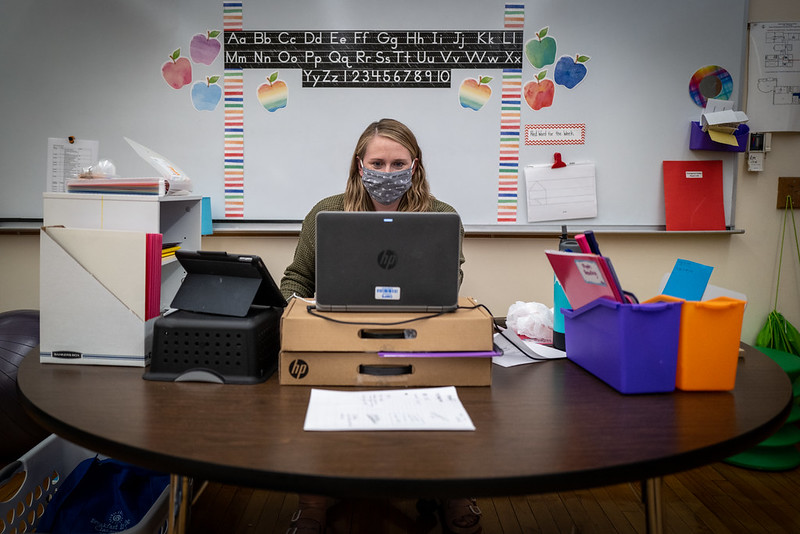WCHS teachers battle anxiety during virtual learning
Due to the sudden switch to distance learning, teachers have had to adjust how to teach their lessons during the pandemic.
October 28, 2020
No one was prepared for the extreme set of obstacles that the pandemic hurled at us. Teachers were especially taken aback in the spring by the switch to distance-learning, scrambling to modify their classes to a technology-reliant structure. Fast forward to the fall, and they are as anxiety-ridden as ever.
It is hard to believe that it has been nearly nine months since major changes hit schools, forcing students, parents and teachers into a new normal. Many of us left school on Mar. 13 feeling exhilarated at the thought of having an extra week of spring break. Little did we know that COVID-19 would still be a part of our everyday lives in October, with no foreseeable end in sight.
As if school is not stressful enough, this year’s crop of teachers at WCHS need to grapple with the fact that all of their lessons are to be taught online with no in-person interaction whatsoever.
“The biggest challenges have been learning how to use all of the new tech, programs, and websites while also figuring out how to use them to teach well…and all from home without getting to have any of the in-person help and support we’re used to,” Charisse Stephens, WCHS Honors English 10 and AP literature teacher, said.
Zoom classrooms also serve as a challenge for building student-teacher relationships. Many teachers have expressed great disappointment in their students not turning their webcam on, which is not a MCPS requirement. Without webcams on, the system defaults to a black screen, which can be frustrating in regards to the amount of engagement and participation teachers see from their students.
“I’m used to being able to see them ruffle their brow when they’re confused, or being able to bring them back on task when they’re dozing off. Now, I’m staring at black holes on a screen,” Matthew Rafferty, Precalculus and Algebra Two teacher, said. “It’s very discouraging and pretty lonely overall. It’s just very hard to build a relationship when I can’t connect the voice to the face. Human beings were designed to communicate by seeing each other and reacting to body language.”
This yields an additional problem when students are hoping for college recommendations from their teachers. If they have had no face-to-face interaction with their teacher throughout the year, the teachers have little to no recollection of who the student is, let alone what qualities they possess.
“I don’t know anybody. I especially won’t remember them if they had their screen off the whole time,” Rafferty said. “When kids come asking for recommendations, I won’t be able to remember their face since we’ve never interacted.”
In addition to their professional lives, teachers have personal lives that also need to be taken into account. This work-life separation that was once distinct, now blurs together as teachers try to juggle how much of the day they want to devote to work and how much of the day they want to devote to their home lives.
Many educators such as Honors U.S. History and AP Human Geography teacher Nicole Van Tassell, share their home’s internet with family members. This can be challenging when everyone needs access to bandwidth-hungry applications like Zoom.
“My husband teaches as well, while my son is currently all virtual and a senior in high school. We have 3 levels of our house, so most days we are all on different levels,” Van Tassell said. “Sometimes the wifi cuts out and all of us lose connection.”
Difficulties like these inevitably produce uncertainty and worry for teachers. Unknowns pop up daily and each teacher has their own way of adapting to the present conditions. Van Tassell explains how she and her colleagues are feeling as a result of the switch to distance learning.
“[We feel] overworked and underappreciated,” Van Tassell said. “Virtual learning is way harder than in school teaching. All our lessons must be manipulated and reworked which takes double the time.”
Anxiety is a progressive feeling as teachers navigate this change on their own while still attempting to teach their students as effectively as possible. According to an April 2020 survey conducted by the University of Phoenix, 75% of teachers were feeling anxious transitioning to virtual learning and 54% were feeling lonely.
In the face of these challenges, teachers are searching for ways to manage the sudden change that has affected schools worldwide. Finding a way to relax is crucial and something that every teacher does slightly differently.
“One thing I do is watch ‘Avatar: The Last Airbender’ with my kids. But I also love poetry as an escape–my favorite poets to ‘unwind’ to are probably Rumi and Mary Oliver,” Stephens said.
It is easy to give in to the negative emotions that seem to be overtaking the world today, however it is important to know that even if you have not met your teachers in person yet, they are still there for you.
“Remember this is temporary. And remember to reach out when you need help. You’re not alone. Every one of you has an army of teachers, counselors, administrators, and friends who want nothing more than to help you be ok. So reach out and let us help,” Stephens said.


